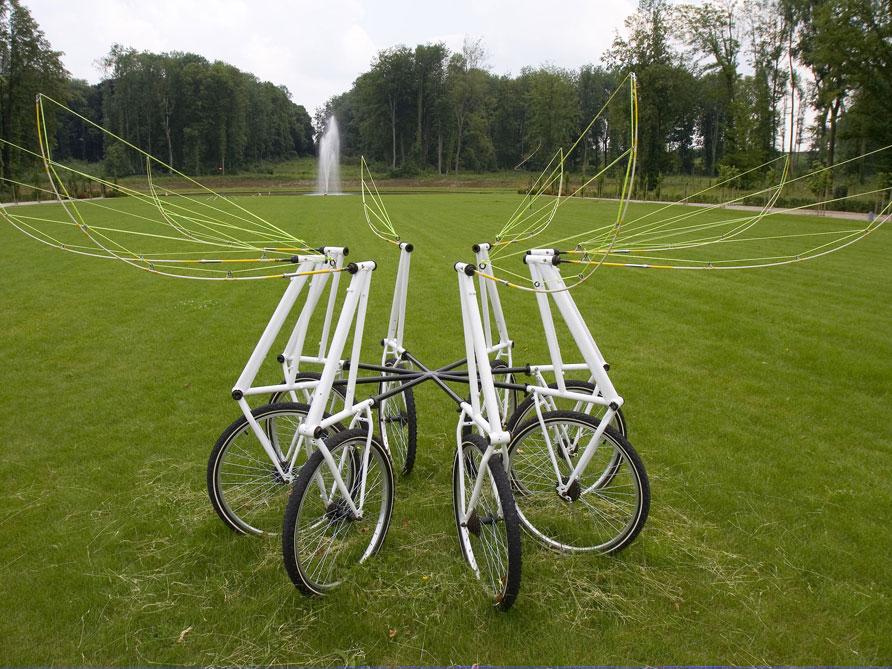Martin Caminiti
Born in 1959
Lives and works in Nice

Objects assembled in unlikely combinations, or rather parts of disarticulated objects, stripped down and reassembled to form something like mysterious useless machines: a wheel and a fishing rod, an elbow-rest and thousands of matches, twigs and a footstool... etc. What to make of these encounters between objects which have nothing to do with each other? Why these assemblages instead of others?
First of all, I see myself more as "a draftsman working in space" than a sculptor. I use these fragile and flexible fishing rods more for their lines, with their upstrokes and downstrokes, than for the object itself with all it suggests. The same holds true for the other elements: fishing traps, pedals, coffee grinder handles are first used for their graphic quality. These three dimensional objects are the equivalents of the marks I I might leave with a brush loaded with ink on a sheet of paper. In effect, lines are drawn and crisscross. By closing spaces, the rods also create other forms, other graphics. The suspended metal wires create thinner lines, at times hardly visible, which can suggest the underdrawing or sketch marks. To complete the metaphor, many of my sculptures are physically shallow and stuck to the wall like a giant sheet of paper. Other are on the ground, allowing one to circulate around them. It's then as if the possibility were granted to penetrate a sheet of paper to discover an unknown virgin space hiding behind the mark, the line, the graphic trace.
Even if it wasn't intended, these assemblages end up resembling bones, skeletons, animal forms, insects, and become allusive silhouettes. Besides, the wall pieces with their light and fragile aspect, have already made me think of a collection of pinned butterflies, when they are stocked in the studio on the same wall!
The floor pieces generally use an entire or deviated object, rather massive, as their base. However, I think they preserve an aerial and mobile quality owing to the simple use of the wheel or objects for transportation in general. In effect, bicycle parts, baby strollers and carriages, plough wheels, shopping carts... etc., suggest displacement and movement. there is almost always an impression of imagined mobility, because in fact these elements are attached to the floor. It is more like a frozen motion, a photographic image.
These different objects thus form a kind of vocabulary from which I can take at will. I articulate, assemble, and oppose them and together they take on meaning. It's not a problem for me if they remain recognizable, for they are not denied their primary function. They simply suggest their everyday while escaping it through a play of associations. The baby stroller with inverted bars extended by twigs is no longer quite the same: it remains identifiable, but I try to plunge it into a bath of poetry and humor through assemblage. It's still a baby stroller but it has lost its utilitarian logic.
And "pow" ! He invents the wheel ! And where does Marcel come in you're probably asking! A certain number of people labeled me as a "post-Duchampian" artist and grandson of the readymade. Some never tire of repeating the obvious. It all begins with the bicycle wheel of course. Sure, I was asking for it. Besides, I'm not the only one, I have many cousins. so, my dear Marcel, I send you my most sincere thoughts and all due reverence !
Martin Caminiti, "Paon" ! Il fait la roue, 2000